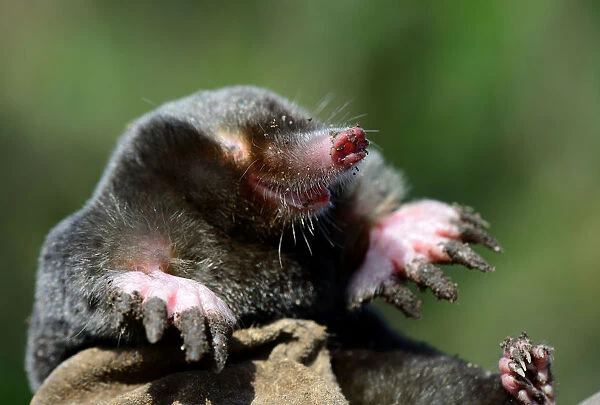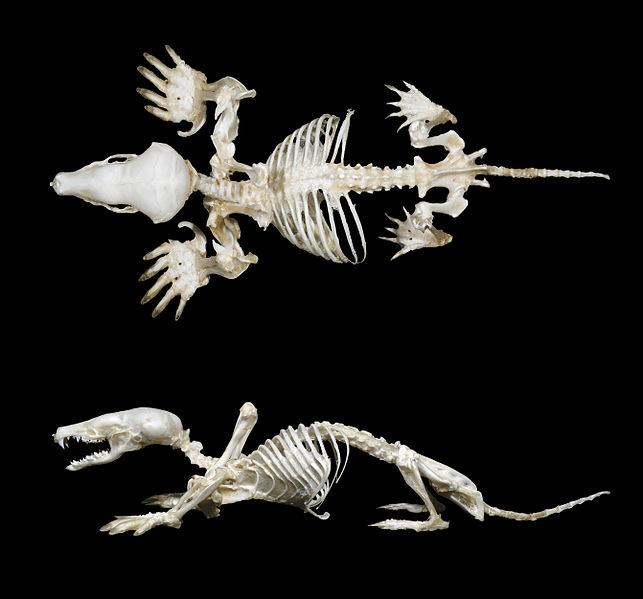In popular culture, very few animals are themselves. Most boil down to archetypes. The all-devouring locust, the ever-loyal and playful dog, the mountable horse. All of these archetypes are then applied imperfectly to unrelated animals. Tyranids and the Zerg are space locusts with a few other archetypes (bees and ants, piranhas, etc.) thrown in for good measure. Every mount in fiction becomes a horse. Every domestic animal absorbs aspects of the dog.
This happens in real life too. Every animal occupies a niche, an environmental role they fulfill. Even unrelated animals will take on similar forms as they live similar lifestyles. Fish aren’t actually all related, but they all take on the same general shape because that’s the most efficient for travelling through the water. Thus it is for moles.

The archetypal fictional mole is quite strange, as it does not resemble any actual mole at all, but more a ground squirrel or a gopher, with brown fur, visible eyes, and prominent incisors, lacking in most common mole species. So to start with, what is a mole, as opposed to any other burrowing mammal, given the term is already pretty arbitrary? Personally, I prefer the interpretation that a mole is an animal that is adapted to live almost entirely underground, doing most feeding, breeding, and raising of young in the earth, as opposed to many burrow-making animals that leave their holes to eat. Typically, a mole has decreased vision and large claws for efficient digging. Most moles are primarily carnivorous, but there’s a few exceptions. With that in mind, let’s find some moles! Today, we’re only covering the “true moles”, of family Talpidae, while next time we’ll get a lot weirder!
European Mole

Nature Picture Library
The European mole, or common mole, shows us the basics of the mole body plan, common especially of those in the “true mole” family. Its body is highly compact and muscular, moving easily both forwards and backwards in their tunnels. Of course, two things stand out immediately even amidst all their lovely charm points; one, no eyes, two, massive hands. These moles only come above ground when they have to, usually when they first leave their mother’s nest and have to find their own territory.
Making up for this lack of sight, moles have a host of what are called Eimer’s Organs, small bumps packed with nerve cells. With these, their senses of touch are incredible, making them the primary way they navigate their world. This world consists mostly of the system of tunnels, most running just ten inches below the surface, but their favored resting tunnels often up to 40 inches deep. More impressive, a solitary mole’s territory can be nearly three acres. Translated into terms most Americans are more familiar with, that’s about 2 and half football fields, all for an animal a little under a foot long. Within this labyrinth, moles are blind minotaurs, hunting any invertebrate that stumbles into their maze. Most animals are eaten immediately, but earthworms are paralyzed with a single bite, then stored for later in special chambers, alive and waiting to be devoured.
Moles are scary.

Wikimedia Commons: Archaeodontosaurus
No seriously. Moles are SCARY.
Star Nosed Mole
/https://public-media.si-cdn.com/filer/20130130041140mole-small.jpg)
Kenneth Catania
Another true mole, star nosed moles are quite famous for their freaky faces, and that really is a hell of a great feature. I wish I had that many sensory tentacles! I love the way it pretty much dominates their entire head, forming an utterly alien false face. Look at those nostrils, like eyes! Crazy! Those Eimer’s Organs we already discussed are incredibly abundant on those tentacles, over 25,000 of them containing over 100,000 nerve endings. Human fingertips have about 17,000 touch fibers, which are roughly comparable to an Eimer’s Organ in sensitivity. They use their incredible sense of touch to find objects and decide whether they’re edible in the blink of an eye.
Star nosed moles are also Amphibious. Unlike most of the true moles, who favor rich but overall dry ground, star nosed moles live mostly in bogs and swamps in the Northeastern USA and Canada. Their large hands aren’t just used for burrowing but swimming. Very often, at one of their tunnel entrances is underwater, allowing them to add fish, amphibians, and aquatic mollusks to their diet.

I love mole claws, and you can see how they’re useful as a paddle too.
Star-noses aren’t just known for their incredible touch but their ability to smell underwater, unknown in other mammals. They blow a bubble from their nose, allowing it to touch a prey item and then withdrawing it to process the scent. With this, they can hunt just as efficiently underwater as in their tunnels.
Shrew Mole

Several different groups are called shrew moles, but they all share the same general shape and lifestyle. They’re adorable little shrew-shaped animals with reduced external ears and pointed heads, and don’t have the oversized claws of their relatives. However, they still dig just like other moles, with big lateral sweeps like they’re swimming or flying. Unlike the proper moles, they do most of their foraging on the surface, digging in leaf litter for insects. The ancestors of the proper true moles might have lived and looked like this.
That lays the groundwork of the moles. These are the animals that all further discoveries were compared about. You thought the star-nose was strange? That’s nothing. It’s gonna get weird, folks.


The star-nosed mole is just too creepy… How come no one thought to use it as a base for a monster? Get on it, DnD writers!